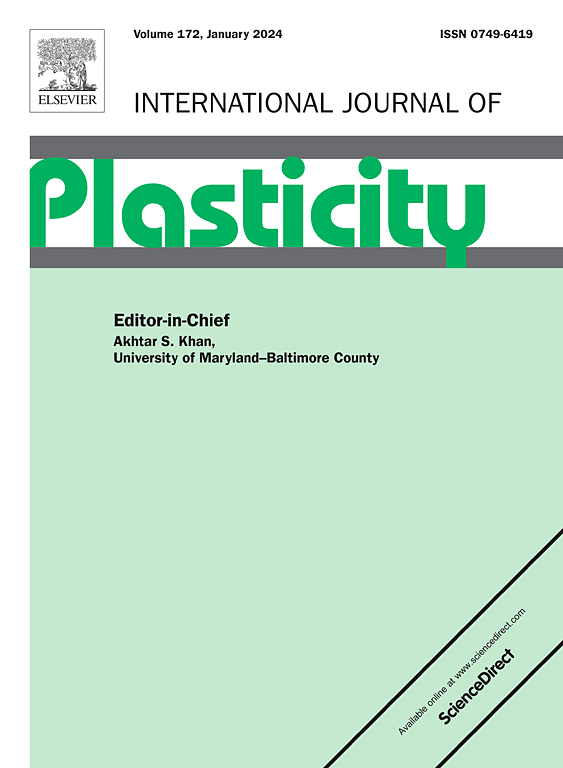Hierarchical deformation and anisotropic behavior of (α+β) Ti alloys: A microstructure-informed multiscale constitutive model study
IF 9.4
1区 材料科学
Q1 ENGINEERING, MECHANICAL
引用次数: 0
Abstract
In this study, the hierarchical deformation and anisotropic behavior of (α+β) Ti alloys are investigated using a novel microstructure-informed multiscale constitutive model. State-of-the-art crystal plasticity finite element (CPFE) models, due to their emphasis on a single length scale, are inadequate for capturing the complex hierarchical behavior of additively manufactured (AM) (α+β) Ti alloys, which are characterized by columnar grains and lamellar subgrain features at distinct length scales. To overcome this limitation, a decoupled multiscale framework was developed, integrating representative volume elements (RVEs) for both the columnar grain structure at the higher length scale and the lamellar subgrain microstructure at the lower length scale, with equal emphasis on each. The material behaviors at these scales were modeled using an anisotropic classical plasticity model and a mechanism-based CPFE model, respectively. The framework was experimentally validated for Directed Energy Deposition (DED) manufactured Ti-6Al-4V. It was then used to investigate microscopic stress/strain fields, deformation localizations at grain and subgrain levels, and stress partitioning among neighboring grains. From the insights gained a new theory of anisotropy for AM (α+β) Ti alloys is proposed.
(α+β) Ti 合金的分层变形和各向异性行为:基于微观结构的多尺度构造模型研究
在本研究中,我们使用一种新型的微结构多尺度构成模型研究了(α+β)钛合金的分层变形和各向异性行为。最先进的晶体塑性有限元(CPFE)模型强调单一长度尺度,不足以捕捉添加制造(AM)(α+β)钛合金的复杂分层行为,这种合金在不同长度尺度上具有柱状晶粒和片状亚晶粒特征。为了克服这一局限性,我们开发了一个解耦多尺度框架,将较高长度尺度上的柱状晶粒结构和较低长度尺度上的亚晶粒微观结构的代表性体积元素(RVE)整合在一起,并对两者给予同等重视。这些尺度上的材料行为分别使用各向异性经典塑性模型和基于机理的 CPFE 模型进行建模。该框架在定向能沉积 (DED) 制造的 Ti-6Al-4V 中得到了实验验证,并用于研究微观应力/应变场、晶粒和亚晶粒级的变形定位以及相邻晶粒间的应力分配。通过这些研究,我们提出了 AM (α+β) 钛合金各向异性的新理论。
本文章由计算机程序翻译,如有差异,请以英文原文为准。
求助全文
约1分钟内获得全文
求助全文
来源期刊

International Journal of Plasticity
工程技术-材料科学:综合
CiteScore
15.30
自引率
26.50%
发文量
256
审稿时长
46 days
期刊介绍:
International Journal of Plasticity aims to present original research encompassing all facets of plastic deformation, damage, and fracture behavior in both isotropic and anisotropic solids. This includes exploring the thermodynamics of plasticity and fracture, continuum theory, and macroscopic as well as microscopic phenomena.
Topics of interest span the plastic behavior of single crystals and polycrystalline metals, ceramics, rocks, soils, composites, nanocrystalline and microelectronics materials, shape memory alloys, ferroelectric ceramics, thin films, and polymers. Additionally, the journal covers plasticity aspects of failure and fracture mechanics. Contributions involving significant experimental, numerical, or theoretical advancements that enhance the understanding of the plastic behavior of solids are particularly valued. Papers addressing the modeling of finite nonlinear elastic deformation, bearing similarities to the modeling of plastic deformation, are also welcomed.
 求助内容:
求助内容: 应助结果提醒方式:
应助结果提醒方式:


